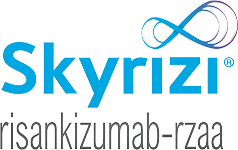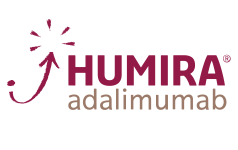For adult patients with active ankylosing spondylitis (AS)
Improvement in signs and symptoms in AS1
ATLAS
Adult patients with active AS1,2
ATLAS study design intro: Double-blind trial of adult patients with active AS. 315 patients were randomized to receive HUMIRA 40 mg EOW (n=208) or placebo (n=107). The co-primary endpoints were percentage of ASAS20 responders at Week 12 and change in mSASSS from baseline to Week 104 for HUMIRA vs OASIS cohort.1-3
ASAS=Assessment of SpondyloArthritis international Society; EOW=every other week; mSASSS=modified Stoke AS Spinal Score; OASIS=Outcome in AS International Study (a historical control cohort of TNF antagonist naïve patients)
Signs and symptoms: ASAS20/50/70 response rates at Week 12 vs placebo1
- HUMIRA 40 mg EOW (n=208)
- Placebo (n=107)
NRI analysisb
aP<0.001
bAnalysis is of the intent-to-treat population (patients who received at least 1 dose of the study medication), using nonresponder imputation (NRI) methodology. Patients who withdrew, had missing values, or received early-escape open-label therapy were considered nonresponders.2
- Similar responses were seen at Week 24 and were sustained in patients receiving open-label HUMIRA for up to 52 weeks1
- ~91% of RCT patients elected to enroll in the OLE4
- Co-primary endpoint: Change in mSASSS from baseline to Week 1043
- Results were not significantly different between the HUMIRA (n=307) and OASIS (n=169) cohorts (0.8 and 0.9, respectively; P=0.771)3
- Responses of patients with total spinal ankylosis (n=11) were similar to those without total ankylosis (results not statistically significant)1
ASAS=Assessment of SpondyloArthritis international Society; EOW=every other week; mSASSS=modified Stoke AS Spinal Score; OASIS=Outcome in AS International Study (a historical control cohort of TNF-antagonist-naïve patients); OLE=open-label extension
Signs and symptoms: ASAS20 response in all 4 ASAS20 criteria at Week 241,8
- HUMIRA 40 mg EOW (n=208)
- Placebo (n=107)
- HUMIRA 40 mg EOW (n=208)
- Placebo (n=107)
LOCF analysisc
Subjects with a zero score at baseline are not included in the analysis of percent change from baseline.
aP<0.001
bMorning stiffness, also referred to as inflammation, is represented by the mean of question 5 and 6 BASDAI (the severity and duration of morning stiffness), mean SD (0–10-cm VAS).2
cLast observation carried forward (LOCF) analysis of intent-to-treat population. If a patient received early-escape open-label prior to Week 24, the last observation prior to early-escape open-label was carried forward.2
ASAS=Assessment of SpondyloArthritis international Society; BASDAI=Bath Ankylosing Spondylitis Disease Activity Index; BASFI=Bath Ankylosing Spondylitis Functional Index; EOW=every other week
Total back pain: improvement from baseline at Week 249
DATA LIMITATIONS
Change from baseline in total back pain at Week 2 was a non-ranked endpoint not controlled for multiplicity; therefore, treatment differences could represent chance findings. No conclusions regarding these comparisons can be made.
- Total back pain was a component of ASAS in the ATLAS trial. Self-assessment (0–10-cm VAS) by the patient: Amount of back pain at any time experienced by the patient during the last week.2
- Subjects with a zero score at baseline are not included in the analysis of percent change from baseline.
ASAS=Assessment of SpondyloArthritis international Society; EOW=every other week; VAS=visual analog scale
Additional measures: BASDAI50* at 12 weeks and 24 weeks2
- HUMIRA 40 mg EOW (n=208)
- Placebo (n=107)
NRI analysisb
aP<0.001
bAnalysis of the intent-to-treat population (patients who received at least 1 dose of the study medication), using nonresponder imputation (NRI) methodology. Patients who withdrew, had missing values, or received "early‑escape" open-label therapy were considered nonresponders.2
*Bath Ankylosing Spondylitis Disease Activity Index (BASDAI) is a composite index including questions on severity of fatigue, spinal and peripheral joint pain, localized tenderness, and morning stiffness, measured on 0-10 VAS scale. BASDAI50 response is defined as at least a 50% improvement over baseline.2
EOW=every other week; VAS=visual analog scale
Safety data: 24-week RCT10
Adverse reaction rates observed in clinical trials may not predict the rates observed in a broader patient population in clinical practice.
Overall RCT 24 Weeks (events per 100 patient-years)
| HUMIRA (n=208) PYs=79.5 |
Placebo (n=107) PYs=32.4 |
|
| SERIOUS INFECTION | 0 | 3.1 |
| MALIGNANCYa | 0 | 0 |
| ACTIVE TUBERCULOSIS | 0 | 0 |
| LYMPHOMA | 0 | 0 |
aExcluding non-melanoma skin cancer and lymphoma
ASAS=Assessment of SpondyloArthritis international Society; PYs=patient-years; RCT=randomized controlled trial
Safety data: treatment-emergent adverse events (AEs) of interest at Week 52 OLE10
Adverse reaction rates observed in clinical trials may not predict the rates observed in a broader patient population in clinical practice.
OLE 52 Weeks (events per 100 PYs)
| HUMIRA (n=304) PYs=286.7 |
|
| SERIOUS AE | 37 (12.9) |
| SERIOUS INFECTION | 5 (1.7) |
| ACTIVE TUBERCULOSIS | 0 |
| MALIGNANCYa | 1 (0.3) |
| LYMPHOMA | 1 (0.3) |
| NON-MELANOMA SKIN CANCER | 0 |
| DEMYELINATING DISORDER | 0 |
aExcluding non-melanoma skin cancer and lymphoma.
ASAS=Assessment of SpondyloArthritis international Society; PYs=patient-years; RCT=randomized controlled trial
RISK OF SERIOUS INFECTION1
Patients treated with HUMIRA are at increased risk for developing serious infections that may lead to hospitalization or death. Most patients who developed these infections were taking concomitant immunosuppressants such as methotrexate or corticosteroids.
Carefully consider the risks and benefits of treatment with HUMIRA prior to initiating therapy in patients with chronic or recurrent infection, or with underlying conditions that may predispose them to infections. Monitor patients closely for the development of signs and symptoms of infection during and after treatment with HUMIRA.
- Do not start HUMIRA in patients with an active infection, including localized infections
- Patients older than 65 years, patients with co morbid conditions, and/or patients taking concomitant immunosuppressants may be at greater risk of infection
RISK OF MALIGNANCY1
Lymphoma, including a rare type of T-cell lymphoma, and other malignancies, some fatal, have been reported in patients treated with TNF blockers, including HUMIRA.
- Consider the risks and benefits of HUMIRA treatment prior to initiating or continuing therapy in patients with a known malignancy
- More cases of malignancies were observed among HUMIRA-treated patients compared to control patients in clinical trials
RISK OF TUBERCULOSIS1
Patients treated with HUMIRA are at increased risk for developing serious infections that may lead to hospitalization or death, including active tuberculosis (TB), including reactivation of latent TB. Patients with TB have frequently presented with disseminated or extrapulmonary disease.
- Test patients for latent TB before HUMIRA use and during therapy. Initiate treatment for latent TB prior to HUMIRA use
- Monitor patients closely for the development of signs and symptoms of infection during and after treatment with HUMIRA, including the development of TB in patients who tested negative for latent TB infection prior to initiating therapy
RISK OF LYMPHOMA1
Lymphoma and other malignancies, some fatal, have been reported in children and adolescent patients treated with TNF blockers, of which HUMIRA is a member.
Postmarketing cases of hepatosplenic T-cell lymphoma (HSTCL), a rare type of T-cell lymphoma, have occurred in adolescent and young adults with inflammatory bowel disease treated with TNF blockers including HUMIRA.
- The rate of lymphoma in controlled and uncontrolled clinical trials of HUMIRA in patients with rheumatoid arthritis, psoriatic arthritis, ankylosing spondylitis, Crohn's disease, ulcerative colitis, plaque psoriasis, hidradenitis suppurativa, and NI uveitis* was approximately 3-fold higher than expected in the general population
- Patients with RA and other chronic inflammatory diseases, particularly those with highly active disease and/or chronic exposure to immunosuppressant therapies, may be at a higher risk for the development of lymphoma.
*Non-infectious (NI) intermediate, posterior, or panuveitis.




